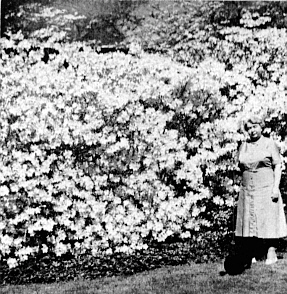R. schlippenbachii in New Jersey
by Edward O. Birch, Short Hills, New Jersey

|
|
Fig. 57.
R. schlippenbachii
growing in
a hedge in Short Hills, N. J. Birch photo |
This photo (Fig. 57) supplements that which appeared in the Bulletin of the Society in April 1956 that showed part of the
Azalea schlippenbachii
border that was planted from seed in 1928; therefore this plant is about thirty years old. The complete border has forty some plants some 12 to 12½ feet high; some with trunks eight to ten inches in diameter at the base. The soil where these plants grow is a good loam as it was an old field of very heavy sod turned over and allowed to rot for about two years. As mentioned in the Bulletin, April 1956 these seedlings were given a light feeding in the spring consisting of mainly cotton seed meal for the first four or five years. Since that time we have used nothing as a fertilizer. At the time they were first planted we followed the usual prescribed care for small seedlings. I later found this unnecessary, for these plants are self sowers, and the new seedlings that sprout under the plants take care of themselves. When they are about two years old I transplant as many as I find room for, but my space is limited.
None of my plants of
R. schlippenbachii
have ever been sprayed or fertilized except the cotton seed meal that I referred to above. The older plants are growing in heavy mats of
Pachysandra
. This does away with mulching and has been proven to be equal to any of the known mulches. I was doubtful though when I first used this type of mulch but I found it takes nothing from the plants and holds the leaf fall of the
R. schlippenbachii
that would normally blow away. I found that after this plant is large enough to be placed in its permanent location it asks for nothing more than to be left strictly alone. I have found that the annual new growth is still from four to six inches, but in some plants it varies a bit.
Each spring the same heavy set of bloom appears, and to date has never failed regardless of what the winter has been. All the large plants have had many heavy coatings of ice that sometimes lasts for two weeks, but there never has been any loss of wood. The branches will bend down and when the thaw comes they spring back to their original position.
R. schlippenbachii
takes our summer heat without flinching, but what they would do in real southern weather I do not know. None of my plants have ever been taken below Maryland. I do know that they are the best all around plant for temperate and cold climates. Plants from my garden have been taken to Ottawa, Canada, Maine, New Hampshire, Vermont, Massachusetts and the most northern part of New York state. This spring some of these plants were taken to Wisconsin and Minnesota, and I expect the reports from there to be most favorable.
I have various azalea species, hybrids and rhododendrons in my garden, but nothing that they offer comes up to
R. schlippenbachii
. The individual blooms in a cluster will average 3½ to 4 inches in diameter, and the color is from very light pink to very dark. Two plants from a distance appear to be white, but a close look will show that they have a tinge of pink in the throat.
These glowing reports may sound exaggerated and too good to be true, and many visitors have come with that thought in mind, but have seen the fine mass of bloom and left convinced. I take no credit for any part of this, but simply believe I was fortunate in getting seed of an exceptional strain that carries on. I think these plants are independent, and do not want to be coddled and should be exposed to the elements in any temperature or cold climate, and they will thrive for years. However remember that while prisoners in your garden, they will not thrive on forced feedings of chemicals no matter what the experts say. A photo of part of my border appeared in a colored advertisement of a prominent chemical company and it read. "Plants like this may be grown with proper applications etc."